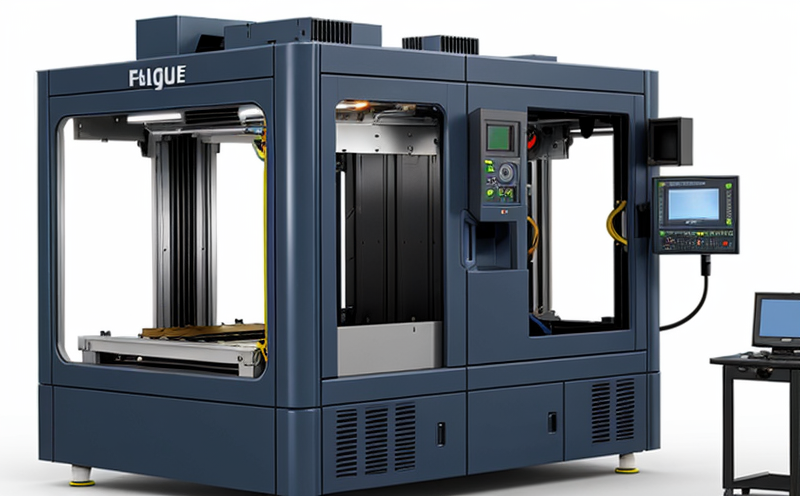ASTM F1800 Fatigue Testing of Ceramic Materials
The ASTM F1800 standard is a critical guideline for fatigue testing of ceramic materials used in additive manufacturing (AM) and 3D printing. This service ensures that components made from these advanced ceramics meet the stringent performance criteria required across various sectors including aerospace, automotive, medical devices, and defense industries.
Ceramic AM parts are increasingly being used due to their exceptional thermal stability, chemical inertness, and mechanical properties. However, fatigue testing is essential to verify long-term reliability in environments that experience cyclic loading. The ASTM F1800 standard provides a framework for cyclic loading tests on ceramic components to assess their resistance under repeated stress cycles.
The testing process involves creating specimens from the specific ceramic material intended for use, which are then subjected to controlled fatigue conditions using specialized equipment capable of precise control over load amplitude and frequency. The primary goal is to determine the number of cycles before failure or the amount of strain energy that can be absorbed without fracture.
Specimen preparation plays a crucial role in ensuring accurate test results. This includes selecting appropriate dimensions for the specimens, ensuring they are free from defects, and maintaining uniformity throughout the production process. Special attention is given to surface finish and geometry to minimize edge effects or localized stress concentrations that could bias the results.
Instrumentation used during ASTM F1800 testing typically involves high-precision strain gauges, displacement sensors, and load cells integrated into fatigue testers designed specifically for small specimen sizes like those found in ceramic AM parts. Data acquisition systems capture real-time data on applied loads, displacements, and strains throughout the test duration.
Reporting of results follows strict protocols outlined by ASTM F1800 to ensure consistency across laboratories performing this type of testing. Reports typically include detailed descriptions of the specimens used, parameters of the fatigue tests conducted, observed behaviors during testing, and conclusions regarding whether the tested materials meet specified performance criteria.
This service not only aids in quality assurance but also supports innovation by providing insights into potential improvements needed for future generations of ceramic AM components. By adhering to internationally recognized standards such as ASTM F1800, manufacturers can ensure their products are reliable and safe for use in demanding applications.
Applied Standards
The ASTM F1800 standard is widely adopted not only because it provides a robust framework but also due to its alignment with other relevant international standards like ISO 5726, which covers fatigue testing of metallic materials. By following these guidelines, laboratories can ensure their tests are consistent and comparable globally.
For instance, the procedure described in ASTM F1800 emphasizes careful selection of test parameters such as stress ratio (R), frequency, and amplitude to mimic actual operating conditions closely. This ensures that the fatigue testing results reflect real-world performance accurately.
- Key Parameters: Stress ratios, frequencies, and amplitudes are critical in ASTM F1800 tests.
- Data Collection: Real-time monitoring of strain, displacement, and load is essential for accurate fatigue testing results.
The standard also stresses the importance of maintaining controlled environmental conditions during testing to prevent external factors from influencing outcomes. This includes temperature control and humidity levels that are crucial in preserving the integrity of ceramic materials.
Scope and Methodology
ASTM F1800 is specifically designed for fatigue testing of ceramic components produced through AM technologies like laser sintering or electron beam melting. The scope encompasses not only conventional ceramics but also composite materials combining metals with ceramics to enhance mechanical properties further.
The methodology outlined in ASTM F1800 involves several key steps including specimen preparation, calibration of test equipment, initiation and execution of fatigue tests, and analysis of collected data. Each step requires meticulous attention to detail to guarantee reliable outcomes.
Specimen preparation is a critical phase where specimens are machined into standard shapes such as cylinders or disks according to the ASTM F1800 specifications. Calibration ensures that all instruments used in testing operate within specified tolerances, thereby minimizing measurement errors.
The initiation of fatigue tests follows strict protocols regarding initial loading conditions and subsequent cycles of increasing stress. During execution, real-time monitoring is conducted using sophisticated instrumentation capable of capturing minute changes in mechanical properties.
Data analysis involves statistical evaluation to interpret the collected data meaningfully. This includes determining the number of cycles to failure (Nf), mean stress-life relationships (M-S curves), and other relevant metrics that characterize fatigue behavior.
Competitive Advantage and Market Impact
- Innovation Leadership: Adherence to ASTM F1800 helps maintain a competitive edge by ensuring products meet the highest quality standards, leading to innovation in product design.
- Regulatory Compliance: Following this standard ensures compliance with regulatory requirements, facilitating easier market entry and broader customer acceptance.
The implementation of ASTM F1800 fatigue testing contributes significantly to the reliability and longevity of ceramic AM parts, thereby enhancing overall product performance. This is particularly beneficial in sectors where component failures could lead to catastrophic consequences or significant costs.
By investing in ASTM F1800-compliant testing services, companies can differentiate themselves by offering superior products that meet stringent quality benchmarks. Moreover, this commitment to high standards builds trust with customers and stakeholders, fostering long-term relationships.
The widespread adoption of ASTM F1800 also drives advancements within the industry as laboratories continue refining their methodologies based on new insights gained from these tests. This continuous improvement cycle ultimately benefits all participants in the AM ecosystem by promoting safer, more reliable products.





